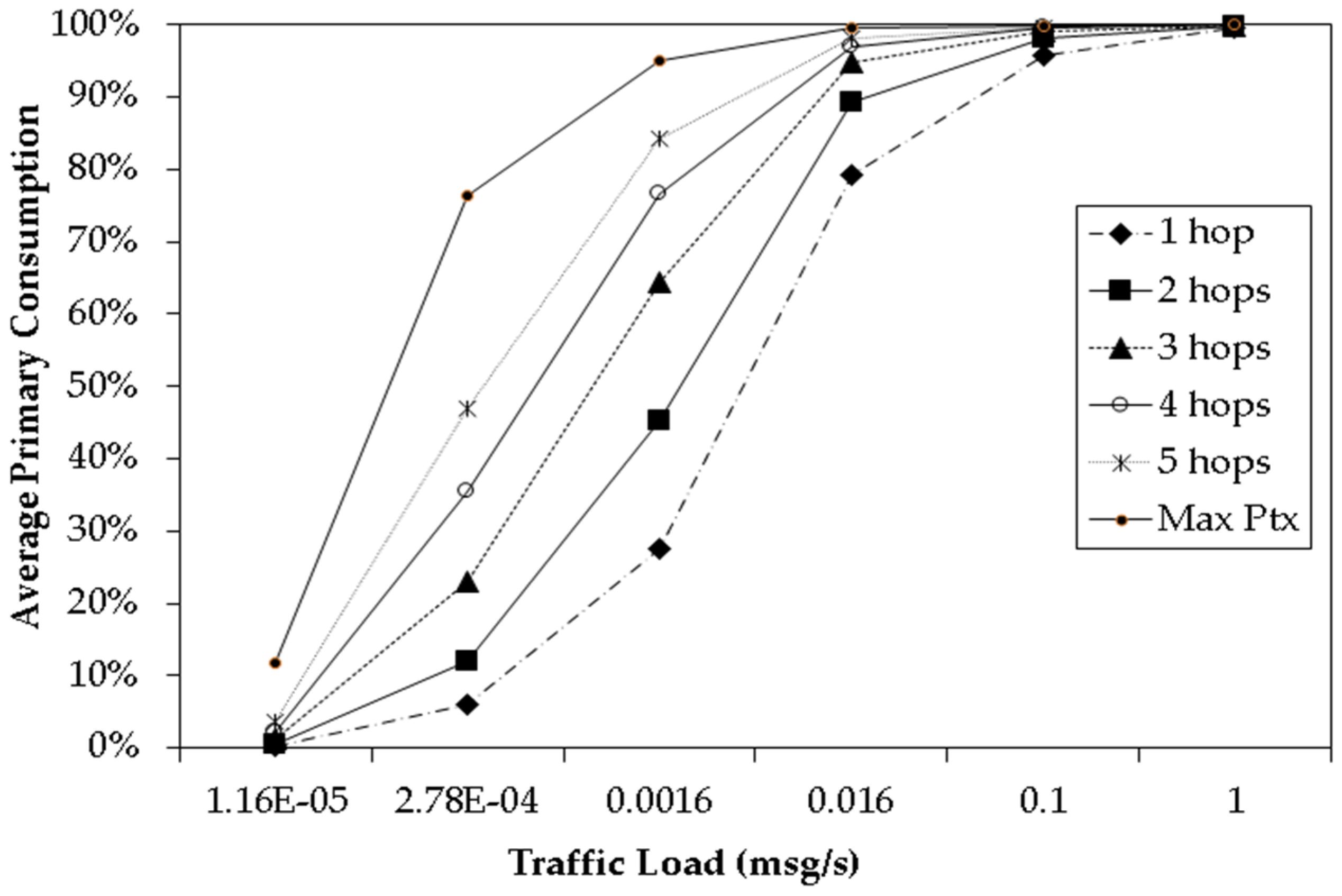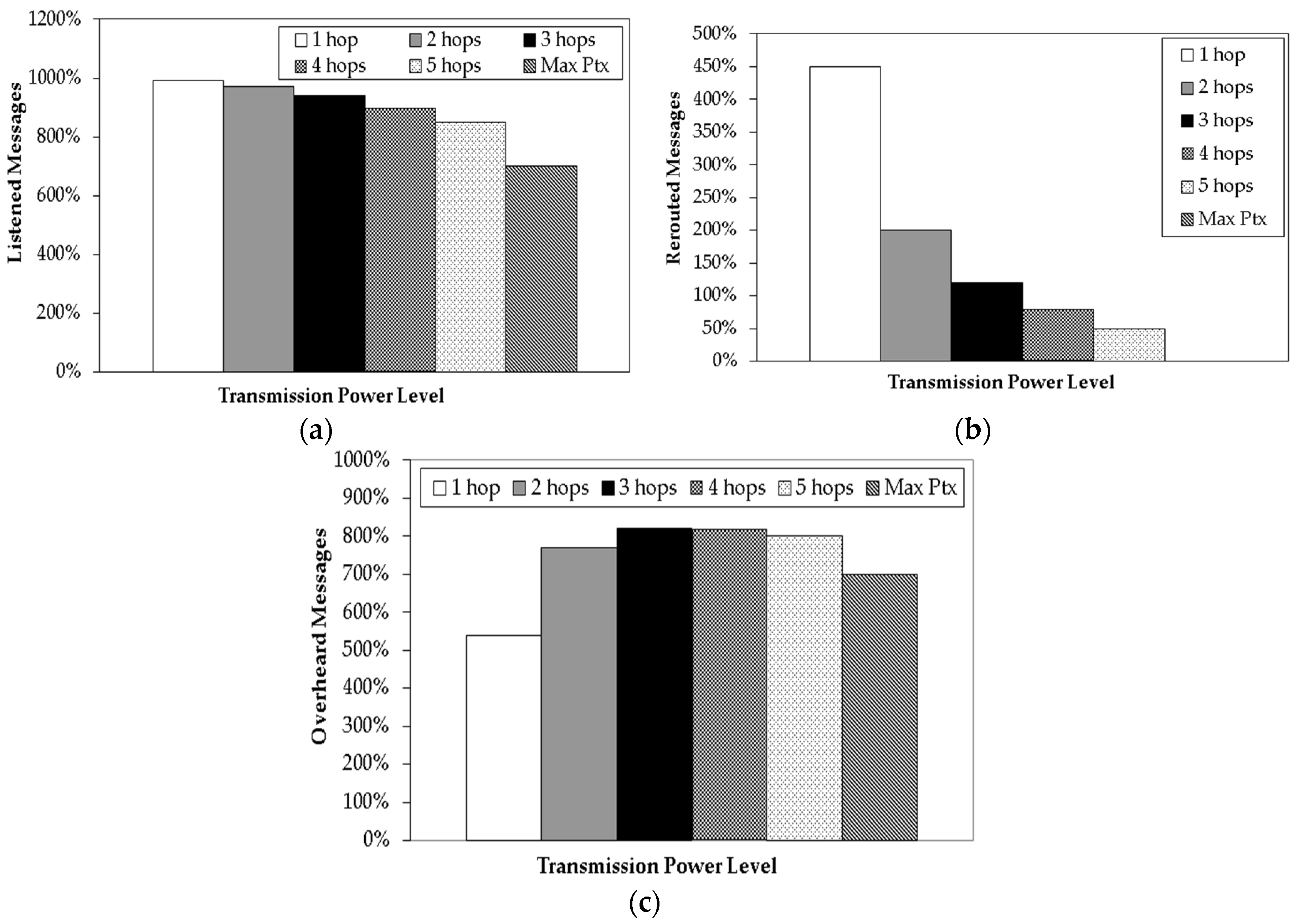An Analysis of the Use of Multiple Transmission Power Levels on Wireless Sensor Networks †
Abstract
:1. Introduction
2. Related Works and Methodology
2.1. Mote Architecture
2.2. Energy Consumption
2.3. Primary and Secondary Energy Consumption
2.4. Transmission Power Levels
2.5. Network Lifetime
2.6. Network Cost
2.7. Message Log
- Listened Messages: All messages received by a mote, regardless their addressee.
- Rerouted Messages: All messages that a mote had to reroute in order to reach the base station.
- Overheard Messages: Only the messages that a mote received but were not addressed to it.
- Generated Messages: All messages created and transmitted by a mote.
3. Simulations and Results
3.1. Primary and Secondary Consumption
3.2. Energy Consumption Profile
3.3. Lifetime
3.4. Network Cost per Working Hour
3.5. Message Log
4. Conclusion
Author Contributions
Funding
Conflicts of Interest
References
- Li, G.; Xu, Z.; Xiong, C.; Yang, C.; Zhang, S.; Chen, Y.; Xu, S. Energy-efficient wireless communications: Tutorial, survey, and open issues. IEEE Wirel. Commun. 2011, 18, 28–35. [Google Scholar] [CrossRef]
- Lian, J.; Naik, K.; Agnew, G.B. Data capacity improvement of wireless sensor networks using non-uniform sensor distribution. Int. J. Distrib. Sens. Netw. 2006, 2, 121–145. [Google Scholar] [CrossRef]
- Akyildiz, I.F.; Su, W.; Sankarasubramaniam, Y.; Cayirci, E. Wireless sensor networks: A survey. Comput. Netw. 2002, 38, 393–422. [Google Scholar] [CrossRef]
- Gao, F.; Li, J.; Jiang, T.; Chen, W. Sensing and Recognition When Primary User Has Multiple Transmit Power Levels. IEEE Trans. Signal Process. 2015, 63, 2704–2717. [Google Scholar] [CrossRef]
- Chen, Z.; Gao, F.; Zhang, X.; Li, J.C.F.; Lei, M. Sensing and Power Allocation for Cognitive Radio with Multiple Primary Transmit Powers. IEEE Wirel. Commun. Lett. 2013, 2, 319–322. [Google Scholar] [CrossRef]
- Freescale Semiconductor Inc. Freescale MC13202 Datasheet with Addendum. Available online: https://www.nxp.com/docs/en/data-sheet/MC13202.pdf (accessed on 31 September 2018).
- Digi International Inc. Digi XBee/XBee-PRO OEM RF Modules Product Manual. Available online: https://www.digi.com/resources/documentation/digidocs/pdfs/90000976.pdf (accessed on 31 September 2018).
- Miranda, F.A.M.; Cardieri, P. The impact of multiple power levels on the lifetime of Wireless Sensor Networks. In Proceedings of the 2016 IEEE International Symposium on Consumer Electronics (ISCE), São Paulo, Brazil, 20–30 September 2016; pp. 103–104. [Google Scholar]
- Miranda, F.A.M.; Cardieri, P. Current Consumption in Radio Modules for Wireless Sensor Networks. In Proceedings of the XXXV Simpósio Brasileiro de Telecomunicações e Processamento de Sinais—SBrT2017, São Paulo, Brazil, 3–6 September 2017. [Google Scholar]
- Vieira, M.A.M.; Coelho, C.N.; da Silva, D.C.; da Mata, J.M. Survey on wireless sensor network devices. In Proceedings of the IEEE Conference on Emerging Technologies and Factory Automation (EFTA 2003), Lisbon, Portugal, 16–19 September 2003; Proceedings (Cat. No.03TH8696). Volume 1, pp. 537–544. [Google Scholar]
- Atmel Corporation. 8-bit Atmel with 8KBytes In-System Programmable Flash ATmega8 ATmega8L Manual. Available online: http://ww1.microchip.com/downloads/en/devicedoc/atmel-2486-8-bit-avr-microcontroller-atmega8_l_summary.pdf (accessed on 31 September 2018).
- Maxim Integrated National Semiconductor LM75 Digital Temperature Sensor and Thermal Watchdog with Two—Wire Interface. 2009.
- Girban, G.; Popa, M. A glance on WSN lifetime and relevant factors for energy consumption. In Proceedings of the 2010 International Joint Conference on Computational Cybernetics and Technical Informatics, Timisoara, Romania, 27–29 September 2010; pp. 523–528. [Google Scholar]
- Rappaport, T.S. Wireless Communications: Principles and Practice, 2nd ed.; Prentice Hall: Upper Saddle River, NJ, USA, 2002. [Google Scholar]
- Mak, N.H.; Seah, W.K.G. How Long is the Lifetime of a Wireless Sensor Network? In Proceedings of the International Conference on Advanced Information Networking and Applications, Bradford, UK, 26–29 May 2009; pp. 763–770. [Google Scholar]
- Hodon, M.; Chovanec, M.; Cechovic, L.; Hudik, M.; Milanova, J.; Kochlan, M.; Jurecka, M.; Kapitulik, J.; Sevcik, P. Maximizing performance of low-power WSN node on the basis of event-driven-programming approach: Minimization of operational energy costs of WSN node control unit. In Proceedings of the IEEE Symposium on Computers and Communication (ISCC), Larnaca, Cyprus, 6–9 July 2015; pp. 204–209. [Google Scholar]
- Feeney, L.M.; Nilsson, M. Investigating the energy consumption of a wireless network interface in an ad hoc networking environment. In Proceedings of the Twentieth Annual Joint Conference of the IEEE Computer and Communications Society (Cat. No.01CH37213), Anchorage, AK, USA, 22–26 April 2001; Volume 3, pp. 1548–1557. [Google Scholar]



| Transmission Power/Reach | Radio-Tx | Radio-Rx | Microcontroller | Sensor |
|---|---|---|---|---|
| 1 hop | 32.03% | 24.70% | 41.18% | 2.08% |
| 2 hops | 77.47% | 11.18% | 10.38% | 0.96% |
| 3 hops | 91.11% | 4.96% | 3.48% | 0.44% |
| 4 hops | 95.57% | 2.61% | 1.56% | 0.24% |
| 5 hops | 97.52% | 1.52% | 0.80% | 0.15% |
| Base station | 99.47% | 0.34% | 0.14% | 0.04% |
| Radio | Microcontroller | Sensor |
|---|---|---|
| 47.61% | 23.81% | 28.58% |
| Traffic Load (msg/s) | Lifetime (in Hours)—1 hop | Lifetime (in Hours)—2 hops | Lifetime (in Hours)—3 hops | Lifetime (in Hours)—4 hops | Lifetime (in Hours)—5 hops | Lifetime (in Hours)—Max Power |
|---|---|---|---|---|---|---|
| 1.16 x 10−5 | 7111.35 | 7067.55 | 6981.56 | 6863.59 | 6568.67 | 4797.62 |
| 2.78 x 10−4 | 6457.86 | 5690.14 | 4595.49 | 3614.01 | 2307.02 | 561.01 |
| 0.00166 | 4364.89 | 2821.47 | 1651.28 | 1041.33 | 526.16 | 100.01 |
| 0.166 | 969.93 | 437.78 | 208.51 | 119.86 | 56.35 | 10.13 |
| 0.1 | 182.28 | 76.89 | 35.62 | 20.26 | 9.45 | 1.69 |
| 1 | 18.65 | 7.76 | 3.57 | 2.10 | 0.94 | 0.17 |
| Traffic Load (msg/s) | Network Cost Per Hour—1 Hop | Network Cost Per Hour—2 Hops | Network Cost Per Hour—3 Hops | Network Cost Per Hour—4 Hops | Network Cost Per Hour—5 Hops | Network Cost Per Hour—Max Power |
|---|---|---|---|---|---|---|
| 1.16 x 10−5 | US$0.06 | US$0.06 | US$0.06 | US$0.06 | US$0.07 | US$0.09 |
| 2.78 x 10−4 | US$0.06 | US$0.07 | US$0.10 | US$0.12 | US$0.19 | US$0.79 |
| 0.00166 | US$0.10 | US$0.16 | US$0.27 | US$0.42 | US$0.84 | US$4.45 |
| 0.166 | US$0.46 | US$1.01 | US$2.13 | US$3.71 | US$7.90 | US$43.94 |
| 0.1 | US$2.44 | US$5.79 | US$12.49 | US$21.97 | US$47.10 | US$263.37 |
| 1 | US$23.86 | US$57.36 | US$124.68 | US$211.95 | US$473.51 | US$2618.23 |
© 2018 by the authors. Licensee MDPI, Basel, Switzerland. This article is an open access article distributed under the terms and conditions of the Creative Commons Attribution (CC BY) license (https://creativecommons.org/licenses/by/4.0/).
Share and Cite
Miranda, F.A.M.; Cardieri, P. An Analysis of the Use of Multiple Transmission Power Levels on Wireless Sensor Networks. Proceedings 2019, 4, 3. https://doi.org/10.3390/ecsa-5-05739
Miranda FAM, Cardieri P. An Analysis of the Use of Multiple Transmission Power Levels on Wireless Sensor Networks. Proceedings. 2019; 4(1):3. https://doi.org/10.3390/ecsa-5-05739
Chicago/Turabian StyleMiranda, Felipe Antonio Moura, and Paulo Cardieri. 2019. "An Analysis of the Use of Multiple Transmission Power Levels on Wireless Sensor Networks" Proceedings 4, no. 1: 3. https://doi.org/10.3390/ecsa-5-05739
APA StyleMiranda, F. A. M., & Cardieri, P. (2019). An Analysis of the Use of Multiple Transmission Power Levels on Wireless Sensor Networks. Proceedings, 4(1), 3. https://doi.org/10.3390/ecsa-5-05739





